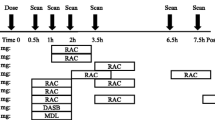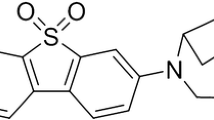Abstract
Rationale
Molecular tools are needed for assessing anti-depressant actions by positron emission tomography (PET) in the living human brain.
Objectives
This study determined whether [11C]mirtazapine is an appropriate molecular tool for use with PET to estimate the magnitude of neuroreceptor occupancy produced by daily intake of mirtazapine.
Methods
This study used a randomised, double-blind, placebo-controlled, parallel-group, within-subject design. Eighteen healthy volunteers were PET-scanned twice with [11C]mirtazapine; once under baseline condition and again after receiving either placebo or mirtazapine (7.5 or 15 mg) for 5 days. We determined kinetic parameters of [11C]mirtazapine in brain regions by the simplified reference region method and used binding potential values to calculate receptor occupancy produced by mirtazapine.
Results
Serum concentrations of mirtazapine ranged from 33 to 56 nmol/l after five daily doses of 7.5 mg mirtazapine and were between 41 and 74 nmol/l after 15 mg mirtazapine. Placebo treatment failed to alter the binding potential of [11C]mirtazapine from baseline values, whereas daily intake of mirtazapine markedly decreased the binding potential in cortex, amygdala and hippocampus. Receptor occupancy ranged from 74 to 96% in high-binding regions of the brain after five daily doses of 7.5 mg or 15 mg mirtazapine, whereas 17–48% occupancy occurred in low-binding regions.
Conclusions
[11C]Mirtazapine together with PET can determine the degree of receptor occupancy produced by daily doses of mirtazapine in regions of the living human brain.


Similar content being viewed by others
References
Adams KH, Pinborg LH, Svarer C, Hasselbalch SG, Holm S, Haugbol S, Madsen K, Frokjaer V, Martiny L, Paulson OB, Knudsen GM (2004) A database of [18F]-altanserin binding to 5-HT2A receptors in normal volunteers: normative data and relationship to physiological and demographic variables. Neuroimage 21:1105–1113
Aldrich MS, Prokopowicz G, Ockert K, Hollingsworth Z, Penney JB, Albin RL (1994) Neurochemical studies of human narcolepsy: alpha-adrenergic receptor autoradiography of human narcoleptic brain and brainstem. Sleep 17:598–608
Brunello N, Blier P, Judd LL, Mendlewicz J, Nelson CJ, Souery D, Zohar J, Racagni G (2003) Noradrenaline in mood and anxiety disorders: basic and clinical studies. Int Clin Psychopharmacol 18:191–202
Collins DL, Neelin P, Peter TM, Evans AC (1994) Automatic 3D intersubject registration of MR volumetric data in standardized Talairach space. J Comput Assist Tomogr 18:192–205
de Boer T (1996) The pharmacologic profile of mirtazapine. J Clin Psychiatry 57(Suppl 4):19–25
de Boer TH, Maura G, Raiteri M, de Vos CJ, Wieringa J, Pinder RM (1988) Neurochemical and autonomic pharmacological profiles of the 6-aza-analogue of mianserin, Org 3770 and its enantiomers. Neuropharmacology 27:399–408
De Vos H, Bricca G, De Keyser J, De Backer JP, Bousquet P, Vauquelin G (1994) Imidazoline receptors, non-adrenergic idazoxan binding sites and alpha2-adrenoceptors in the human central nervous system. Neuroscience 59:589–598
Drevets WC (2000) Functional anatomical abnormalities in limbic and prefrontal cortical structures in major depression. Prog Brain Res 126:413–431
Farde L, Nordstrom AL, Wiesel FA, Pauli S, Halldin C, Sedvall G (1992) Positron emission tomographic analysis of central D1 and D2 dopamine receptor occupancy in patients treated with classical neuroleptics and clozapine. Relation to extrapyramidal side effects. Arch Gen Psychiatry 49:538–544
Fava M, Dunner DL, Greist JH, Preskorn SH, Trivedi MH, Zajecka J, Cohen M (2001) Efficacy and safety of mirtazapine in major depressive disorder patients after SSRI treatment failure: an open-label trial. J Clin Psychiatry 62:413–420
Fava M, Rush AJ, Wisniewski SR, Nierenberg AA, Alpert JE, McGrath PJ, Thase ME, Warden D, Biggs M, Luther JF, Niederehe G, Ritz L, Trivedi MH (2006) A Comparison of Mirtazapine and Nortriptyline Following Two Consecutive Failed Medication Treatments for Depressed Outpatients: A STAR*D Report. Am J Psychiatry 163:1161–1172
Folstein MF, Folstein SE, McHugh PR (1975) "Mini-mental state". A practical method for grading the cognitive state of patients for the clinician. J Psychiatr Res 12:189–198
Grasby PM (1999) Imaging strategies in depression. J Psychopharmacol 13:346–351
Holmberg M, Fagerholm V, Scheinin M (2003) Regional distribution of alpha(2C)-adrenoceptors in brain and spinal cord of control mice and transgenic mice overexpressing the alpha2C-subtype: an autoradiographic study with [3H]RX821002 and [3H]rauwolscine. Neuroscience 117:875–898
Jakobsen S, Pedersen K, Smith DF, Jensen SB, Munk OL, Cumming P (2006) Detection of alpha2-adrenergic receptors in brain of living pig with 11C-Yohimbine. J Nucl Med 47:2008–2015
Kabani N, MacDonald D, Holmes C, Evans AC 3D Atlas of the human brain.(1998) Fourth International Conference on Functional Mapping of the Human Brain, Montreal, Quebec, Canada
Kent JM (2003) SNaRIs, NaSSAs, and NaRIs: new agents for the treatment of depression. Lancet 355:911–918
Lammertsma AA, Hume SP (1996) Simplified reference tissue model for PET receptor studies. Neuroimage 4:153–158
Laruelle M, Slifstein M, Huang Y (2002) Positron emission tomography: imaging and quantification of neurotransporter availability. Methods 27:287–299
Lundberg J, Christophersen JS, Petersen KB, Loft H, Halldin C, Farde L (2007) PET measurement of serotonin transporter occupancy: a comparison of escitalopram and citalopram. Int J Neuropsychopharmacol 1–9
Marthi K, Bender D, Gjedde A, Smith D (2002a) [11C]Mirtazapine for PET neuroimaging: radiosynthesis and initial evaluation in the living porcine brain. Eur Neuropsychopharmacol 12:427–432
Marthi K, Bender D, Watanabe H, Smith DF (2002b) PET evaluation of a tetracyclic, atypical antidepressant, [N-methyl-11C]mianserin, in the living porcine brain. Nucl Med Biol 29:317–319
Marthi K, Hansen SB, Jakobsen S, Bender D, Smith SB, Smith DF (2003) Biodistribution and radiation dosimetry of [N-methyl-11C]mirtazapine, an antidepressant affecting adrenoceptors. Applied Radiation and Isotopes 59:175–179
Marthi K, Jakobsen S, Bender D, Hansen SB, Smith SB, Hermansen F, Rosenberg R, Smith DF (2004) [N-methyl-11C]Mirtazapine for positron emission tomography neuroimaging of antidepressant actions in humans. Psychopharmacology (Berl) 174:260–265
Mayberg H (2002) Depression, II: localization of pathophysiology. Am J Psychiatry 159:1979
McGrath PJ, Stewart JW, Fava M, Trivedi MH, Wisniewski SR, Nierenberg AA, Thase ME, Davis L, Biggs MM, Shores-Wilson K, Luther JF, Niederehe G, Warden D, Rush AJ (2006) Tranylcypromine versus venlafaxine plus mirtazapine following three failed antidepressant medication trials for depression: a STAR*D report. Am J Psychiatry163:1531–1541
Meyer JH, Wilson AA, Ginovart N, Goulding V, Hussey D, Hood K, Houle S (2001) Occupancy of serotonin transporters by paroxetine and citalopram during treatment of depression: a [11C]DASB PET imaging study. Am J Psychiatry158:1843–1849
Meyer JH, Wilson AA, Sagrati S, Hussey D, Carella A, Potter WZ, Ginovart N, Spencer EP, Cheok A, Houle S (2004) Serotonin transporter occupancy of five selective serotonin reuptake inhibitors at different doses: an [11C]DASB positron emission tomography study. Am J Psychiatry161:826–835
Millan MJ (2006) Multi-target strategies for the improved treatment of depressive states: Conceptual foundations and neuronal substrates, drug discovery and therapeutic application. Pharmacol Ther 110:135–370
Millan MJ, Gobert A, Rivet JM, Adhumeau-Auclair A, Cussac D, Newman-Tancredi A, Dekeyne A, Nicolas JP, Lejeune F (2000) Mirtazapine enhances frontocortical dopaminergic and corticolimbic adrenergic, but not serotonergic, transmission by blockade of alpha2-adrenergic and serotonin2C receptors: a comparison with citalopram. Eur J Neurosci 12:1079–1095
Reis M, Prochazka J, Sitsen A, Ahlner J, Bengtsson F (2005) Inter- and intraindividual pharmacokinetic variations of mirtazapine and its N-demethyl metabolite in patients treated for major depressive disorder: a 6-month therapeutic drug monitoring study. Ther Drug Monit 27:469–477
Remington G, Mamo D, Labelle A, Reiss J, Shammi C, Mannaert E, Mann S, Kapur S (2006) A PET study evaluating dopamine D2 receptor occupancy for long-acting injectable risperidone. Am J Psychiatry163:396–401
Seminowicz DA, Mayberg HS, McIntosh AR, Goldapple K, Kennedy S, Segal Z, Rafi-Tari S (2004) Limbic-frontal circuitry in major depression: a path modeling metanalysis. Neuroimage 22:409–418
Smith DF, Dyve S, Minuzzi L, Jakobsen S, Munk OL, Marthi K, Cumming P (2006) Inhibition of [11C]mirtazapine binding by alpha2-adrenoceptor antagonists studied by positron emission tomography in living porcine brain. Synapse 59:463–471
Stahl SM (2006) Essential Psychopharmacology. The Prescriber’s Guide. Cambridge University Press, New York, NY
Stimmel GL, Dopheide JA, Stahl SM (1997) Mirtazapine: an antidepressant with noradrenergic and specific serotonergic effects. Pharmacotherapy 17:10–21
Strazielle C, Lalonde R, Hebert C, Reader TA (1999) Regional brain distribution of noradrenaline uptake sites, and of alpha1-alpha2- and beta-adrenergic receptors in PCD mutant mice: a quantitative autoradiographic study. Neuroscience 94:287–304
Szegedi A, Schwertfeger N (2005) Mirtazapine: a review of its clinical efficacy and tolerability. Expert Opin Pharmacother 6:631–641
Tagawa M, Kano M, Okamura N, Higuchi M, Matsuda M, Mizuki Y, Arai H, Iwata R, Fujii T, Komemushi S, Ido T, Itoh M, Sasaki H, Watanabe T, Yanai K (2001) Neuroimaging of histamine H1-receptor occupancy in human brain by positron emission tomography (PET): a comparative study of ebastine, a second-generation antihistamine, and (+)-chlorpheniramine, a classical antihistamine. Br J Clin Pharmacol 52:501–509
Talairach P, Tournoux P (1988) Co-planar Stereotaxic Atlas of the Human Brain: 3-Dimensional Proportional system: An Approach to Cerebral Imaging. Georg Thieme, Stuttgart
Talbot PS, Laruelle M (2002) The role of in vivo molecular imaging with PET and SPECT in the elucidation of psychiatric drug action and new drug development. Eur Neuropsychopharmacol 12:503–511
Timmer CJ, Paanakker JE, van Hal HJM (1996) Pharmacokinetics of mirtazapine from orally administered tablets: influence of gender, age and treatment regimen. Human Psychopharmacology 11:497–509
Timmer CJ, Sitsen JM, Delbressine LP (2000) Clinical pharmacokinetics of mirtazapine. Clin Pharmacokinet 38:461–474
Versiani M, Moreno R, Ramakers-van Moorsel CJ, Schutte AJ (2005) Comparison of the effects of mirtazapine and fluoxetine in severely depressed patients. CNS Drugs 19:137–146
Videbech P, Ravnkilde B, Pedersen AR, Egander A, Landbo B, Rasmussen NA, Andersen F, Stodkilde-Jorgensen H, Gjedde A, Rosenberg R (2001) The Danish PET/depression project: PET findings in patients with major depression. Psychol Med 31:1147–1158
Wilson AA, Johnson DP, Mozley D, Hussey D, Ginovart N, Nobrega J, Garcia A, Meyer J, Houle S (2003) Synthesis and in vivo evaluation of novel radiotracers for the in vivo imaging of the norepinephrine transporter. Nucl Med Biol 30:85–92
Yasuno F, Hasnine AH, Suhara T, Ichimiya T, Sudo Y, Inoue M, Takano A, Ou T, Ando T, Toyama H (2002) Template-based method for multiple volumes of interest of human brain PET images. Neuroimage 16:577–586
Zilles K, Qu M, Schleicher A (1993) Regional distribution and heterogeneity of alpha-adrenoceptors in the rat and human central nervous system. J Hirnforsch 34:123–132
Acknowledgements
Funded by the Danish Medical Research Council, the A.P. Møller Foundation for the Advancement of Medical Science, and the Max and Inger Woerzner Foundation.
Dr. Donald F. Smith reports no competing interests. The authors thank Dr. Marie M. Nielsen, the bioanalysts at the PET Center and Center for Psychiatric Research, and the technicians at the PET Center for their skilful assistance.
Author information
Authors and Affiliations
Corresponding author
Rights and permissions
About this article
Cite this article
Smith, D.F., Stork, B.S., Wegener, G. et al. Receptor occupancy of mirtazapine determined by PET in healthy volunteers. Psychopharmacology 195, 131–138 (2007). https://doi.org/10.1007/s00213-007-0877-x
Received:
Accepted:
Published:
Issue Date:
DOI: https://doi.org/10.1007/s00213-007-0877-x




